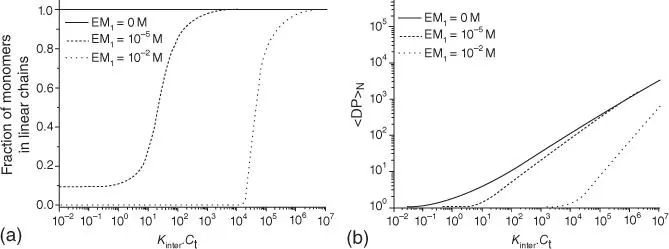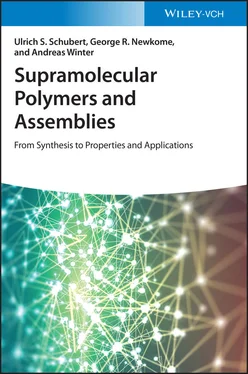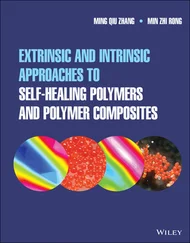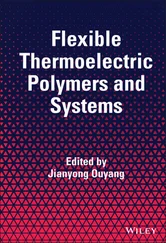(1.4) 
where EM: effective molarity, K intra: dimensionless equilibrium constant for the intramolecular reaction, K inter: association constant (M −1) for an intermolecular reaction.
In the case of a supramolecular polymerization in which a heteroditopic AB‐type monomer is used, EM defines the limit monomer concentration below which the (macro)cyclization pathway dominates the linear chain growth. This empirical approach allows one to predict the different cyclization reactions and, even more importantly, gives an absolute measure for a monomer's cyclization ability at the cost of its polymerization (valid only for reversible, non‐covalent interactions).
For thermodynamically controlled step‐growth polymerizations, Jacobsen and Stockmayer predicted a critical concentration limit [87]: the system is exclusively composed of cyclic species below this value; above this value, an excess of monomer exclusively gives linear chains while the concentration of cyclic species stays constant ( Figure 1.10b). These authors related the equilibrium constant for the cyclization to the probability for, thus directly connecting EM and c eff. It was additionally shown that this constant would decrease with N −5/2; in other words, a macrocycle composed of N subunits can reopen in N different ways. This study was extended by Ercolani et al., who also considered the size distribution of macrocycles under dilute conditions; thereby, a broad range of K avalues for the supramolecular macrocyclization were taken into account [83]. According to this, only for high K avalues (>10 5M −1) can a critical concentration limit be observed.
The later model is particularly suited for describing the equilibrium, which is established between cyclic and linear species during a supramolecular polymerization (they are typically conducted in relatively dilute solutions). In contrast to an IDP ( vide infra ), which commonly features K as the only thermodynamic constant, Ercolani's ring‐chain model involves two such constants ( Figure 1.9): K interand K intra(n‐mer)(the latter represents the intramolecular binding constant for the n ‐th ring closure). Considering all cycles as unstrained and obeying Gaussian statistics, the EM n‐mervalues can simply be expressed as a function of EM 1(EM 1: effective molarity of the bifunctional monomer itself; Eq. (1.5)). An additional aspect that needs to be briefly mentioned is the role of the solvent: thus, volume effects cannot be neglected, and the exponent in Eq. (1.5)needs to be adjusted [62,88–90].
(1.5) 
where EM n‐mer: effective molarity of the n ‐mer, K intra(n‐mer): intermolecular binding constant for the n ‐th ring closure, K inter: association constant (M −1) for an intermolecular reaction, EM 1: effective molarity of the bifunctional monomer.
Due to an additional parameter, which is the critical concentration, the situation becomes even more complex when compared to the previously discussed IDP. To account for this, the monomer fraction in linear species as well as the Nand Wvalues were calculated for a general ring‐chain equilibrium, which only involved unstrained macrocycles (i.e. various K intra(1)values were considered, K inter= 10 6M −1) [26, 83]. As shown in Figure 1.11a, the transition between cyclic and linear species at the critical concentration becomes much sharper when K intra(1)is increased. In addition, both Nand Wexhibit a steep increase for c t> EM 1(the sharpness of the transition still depends on K intra(1)). In contrast, in an IDP, the DP gradually rises with increasing concentration. However, at high total concentrations, it is no longer possible to distinguish between the different modes of polymerization (i.e. the IDP or the ring‐chain equilibrium polymerization), and the obtained DPs are almost identical at given concentrations that are much higher than the EM 1value ( Figure 1.11b).

Figure 1.11 (a) Illustration of the fraction of polymerized monomer as a function of K inter· c tfor three different EM 1values and a fixed value of K inter(10 6M −1). (b) Illustration of the evolution of Nas a function of K inter· c tfor various EM 1values.
Source: Flory and Suter [91].
Dormidontova and coworker addressed the issue of the spacer's rigidity with respect to the ring‐chain equilibrium of supramolecular polymers [92]. Applying Monte Carlo simulations on such supramolecular polymerizations, these authors showed that the critical concentration was strongly dependent on the rigidity of the spacer (in these modeling studies, H‐bonding interactions were representatively studied). Keeping all further parameters constant (e.g. the length of the spacer or the energy for the interaction of the end groups), the critical concentration decreased in the following order: rigid > semi‐flexible > flexible. Thus, for rigid and semi‐flexible systems, the probability of their end groups meeting within a bonding distance and, thus, the formation of rings, is much smaller as for flexible systems.
Various groups have reported on critical temperatures in ring‐chain equilibria ( T c). These values define the transition between macrocyclic and linear species of high molar mass [71, 72, 93]. Like the supramolecular IDP elaborated in Section 1.3.1, one has to also distinguish two limiting cases for the ring‐chain equilibrium polymerization [56]:
1 Above a certain ceiling temperature, polymers of high molar mass are thermodynamically less stable than cyclic monomers or oligomers.
2 Below a certain floor temperature, polymers of high molar mass are thermodynamically less stable than cyclic monomers/oligomers.
In other words, a ceiling temperature can be found in those (supramolecular) polymerizations where negative changes in the enthalpy and entropy of propagation occur; in the second case, the changes in these measures are positive and, consequently, the floor temperature defines the limit below which (supramolecular) polymerization cannot occur.
Covalent ROPs typically involve the opening of strained cycles (e.g. the cationic polymerization of tetrahydrofuran [THF] and dioxolane [42]). In general, such polymerizations represent enthalpy‐driven processes for which ceiling temperatures can be observed (basically, all species are of cyclic nature above this value). Very few examples are known for ROPs exhibiting a floor temperature [94]. Examples for such processes that are characterized by a gain in entropy are the ROP of cyclic S 8in liquid sulfur [93] and the ROMP of unstrained, macrocyclic olefins [70].
Also in the “supramolecular world,” the ring‐chain equilibrium polymerization is a common feature, independent of the type of employed non‐covalent interactions. Representative examples in this respect are the formation of pseudorotaxanes (i.e. the supramolecular polymerization of crown ether derivatives equipped with a pending positively charged amine; Figure 1.12, see Chapter 6) [95–97], the polymerization of poly(dimethylsiloxane)s functionalized in α , ω ‐position with carboxylic acids (see Chapter 2) [98], and the equilibrium between linear, tape‐like, and cyclic structures that can be observed in stoichiometric mixtures of cyanuric acid and melamine derivatives (see Chapter 3) [99].
Читать дальше















